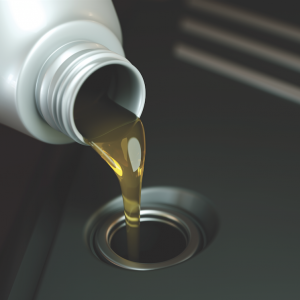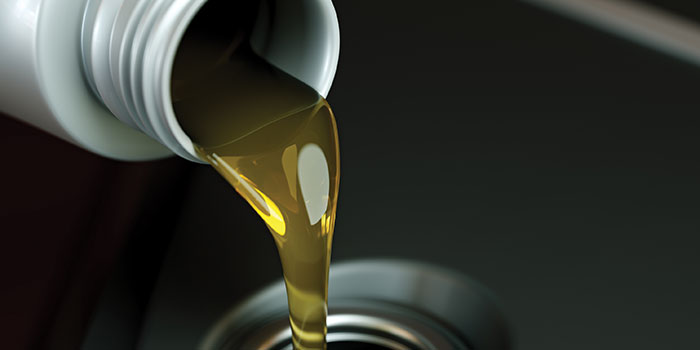 As engine technology has evolved and fuel efficiency standards have tightened, oil specs have increased in importance. Using the wrong viscosity could set a fault code in some applications or interfere with the normal operation of the variable valve timing system.
As engine technology has evolved and fuel efficiency standards have tightened, oil specs have increased in importance. Using the wrong viscosity could set a fault code in some applications or interfere with the normal operation of the variable valve timing system.
VVT engines not only require a specific oil viscosity, but also require an oil that keeps the pulse-modulated variable valve timing solenoids clean, lubricated and free of small air bubbles.
Direct injection engines require anti-scuffing properties to prevent damage to the camshaft fuel pump eccentric and cam follower on the high-pressure mechanical fuel pump. When the wrong oil is used, the camshaft eccentric eventually begins wearing away the lobes.
Following oil recommendations might seem obvious, but a 2013 study by the American Petroleum Institute (API) determined that almost 1 in 5 samples of bulk motor oil purchased from the marketplace in each of the last five years failed to meet API motor oil performance standards. And that’s just the basic API standards. What about all of the OE-specific specs?
A year ago, some states even started implementing new rules from the National Conference on Weights and Measures (NCWM) that will require service facilities to label bulk containers, print the oil information on all job tickets and retain the paperwork for at least one year.
ILSAC rating
The International Lubricants Standardization and Approval Committee (ILSAC) is the gatekeeper of oil standards.
ILSAC GF -1,-2,-3,-4 and -5 are specifictions for multigrade oils that started in 1992. GF-5 certified oils are compatible with previous GF 1-4 oils.
The GF-5 requirements were created in 2010. They were designed to provide improved high temperature deposit protection for pistons and turbochargers, more stringent sludge control, improved fuel economy, enhanced emission control system compatibility, seal compatibility, and protection of engines operating on ethanol-containing fuels up to E85.
Higher viscosity oils cannot meet an ILSAC GF-5 rating. The G-5 rating corresponds closely to the API SN rating.
ACEA rating
European car manufacturers are perhaps the most focused on extended interval oil options, and these manufacturers abide by the standards set by the European Automobile Manufacturer’s Association (ACEA), which is based on testing developed by the European Engine Lubricants Quality Management System (EELQMS).
European oils usually have a higher viscosity, clocking near SAE 10w-50 or 5w-40 and require robust additive packages to meet the extended oil change interval.
“A” and “B” (1-5) rated oils are stable, stay-in-grade oils intended for use at extended drain intervals in gasoline engines and diesel engines (car and light van). These are specifically designed to be capable of using low friction low viscosity oils with a high temperature/high shear (HTHS) rate viscosity.
The “C” rating designation is for catalytic converter equivalent oils. They are A5/B5 oils with a low sulfated ash, phosphorous and sulfur content.
In addition to those oil spec standards, certain manufacturers have their own set of standards. Be sure to check that whichever oil you use specifies its compliance with each set of standards. Most OE oil specifications require the oil be able to endure the long drain interval or match the oil life index number. Below are some of the most notable OE oil specs.
Volkswagen
Volkswagen has issued 11 different motor oils specifications over the years. Most Volkswagens made after 2000 have the long drain interval option or WIV (Wartungs Intervall Verlängerung or longer service intervals). Volkswagen started with VW 500.00 and it is currently developing VW 508.00.
The progression of its oil standards is in response to changing vehicle injection technology (gas and diesel) and lighter oil viscosities. Also, specifications were issued to meet changing emission mandates limiting sulfur, ash and phosphates (SAP).
Some of the standards and variants are for vehicles you may never see like the Lupo. Many of the oil standards supercede or improve previous specifications and are back-date compatible. This means a vehicle that specifies VW 502 oil can use VW 504 oil.
To select the correct oil that meets the VW standards, check the owner’s manual or repair information database. Your oil supplier may even have a guide on its website. You can also check the oil manufacturer product data sheets to see which specifications an oil meets. You will be suprised what mass market synthetic oils meet VW’s stringent specifications for VW 507.
Audi has a similar list of specs — 501.01, 502.00, 505.00, 505.01, 504.00 and 507.00 — and TSB 17-12-29 is a handy list every oil that meets its specs.
Mercedes-Benz
Mercedes-Benz oils follow the same oil specification trends as other German manufacturers that have had to update to lighter weight oils to meet Euro 4 emission standards and drain intervals. Some of these standards even cover Chrysler vehicles. For full lists of approved Mercedes-Benz oils, head to bevo.mercedes-benz.com.
BMW
BMW has only three oil specifications — BMW Longlife-98, BMW Longlife-01 and BMW Longlife-04. These oils typically meet and exceed ACEA and API SJ/CD standards.
BMW Longlife-04 oils require special BMW approval for fully synthetic long-life oil. Longlife-04 is backdate compatible where Longlife-98 or BMW Longlife-01 is recommended.
Toyota / Lexus
Toyota Genuine Motor Oil is designed for reduced friction when the engine starts and for reducing stress from heat. Sludging problems have been an issue with Toyotas, so oil specs lean toward synthetics that reduce this tendency. Most Toyotas today specify GF-5, SAE 0w-20, but state that 5w-20 may be used if replaced with 0w-20 the next oil change.
Honda
Honda specifies mostly 0w-20 or 5w-20, but there is a unique spec to note for the 2007 Acura RDX. This requires Honda/Acura HTO-06 motor oil, which was developed to ensure adequate protection for turbocharged engines. A motor oil that meets this spec will note it on the label.
Courtesy Underhood Service.














